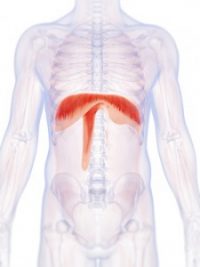
WHAT’S THE PHRENIC NERVE?
Your body has two phrenic nerves, a left and a right one. Each originates in the neck and passes down between the lung and heart to reach the diaphragm. These nerves play a pivotal part in breathing – passing motor information to the diaphragm.
WHAT IS PHRENIC NERVE STIMULATION?
Phrenic nerve stimulation, also known as diaphragm pacing, is the electrical stimulation of the phrenic nerve using a surgically implanted device. This device contracts the diaphragm rhythmically, improving breathing function in patients with respiratory insufficiency.
HOW DOES IT WORK?
The external transmitter and antennas of the phrenic nerve stimulator send radio frequency energy to the implanted receivers just under the skin. The receivers then convert the radio waves into electrical pulses. These pulses are then sent down the electrodes to the phrenic nerves, causing the diaphragm to contract. This contraction causes the patient to inhale. When the pulses stop, the diaphragm relaxes and the patient exhales. Repetition of this series of pulses produces a normal breathing pattern.
WHO IS ELIGIBLE?
Patients with partial or complete respiratory insufficiency who have an intact phrenic nerve and diaphragm may be eligible for phrenic nerve stimulation. Common diagnoses include patients with spinal cord injury, central sleep apnea, and diaphragm paralysis.
HOW IS IT IMPLANTED?
A phrenic nerve stimulator is implanted surgically by placing an electrode under the phrenic nerve, either in the neck or in the chest. This electrode is connected to a radiofrequency receiver which is implanted just under the skin. The surgery can be performed at a hospital close to the patient’s home by the surgeon of their choice. The procedure averages two to four hours, and the patient is typically discharged from the hospital after one or two days. Some procedures can be performed on an outpatient basis. Find out more about the surgical details.
THE AVERY DIAPHRAGM PACING SYSTEM SYSTEM
The Avery Diaphragm Pacing System System is the only diaphragm pacing system fully approved for adults and children under USFDA Premarket approval (PMA) and CE marking privileges under the European Active Implantable Medical Device Directive. In addition, its system of using small implanted radiofrequency receivers rather than electrode wires that pass directly through the skin decreases a patient’s risk of infection and ongoing wound care management issues.
Learn more about the About the Avery Diaphragm Pacing System
Content reviewed July, 2024 by Dr. Don Headley, M.D.
Dr. Headley is an otolaryngologist (ENT) with almost 40 years of experience in medicine. He is a graduate of George Washington University School of Medicine and Health Science, has been affiliated with St. Joseph’s Hospital and Medical Center in Phoenix, Arizona, and previously served as assistant professor of Internal Medicine and Surgery and Creighton University Medical School in Omaha, NE.



